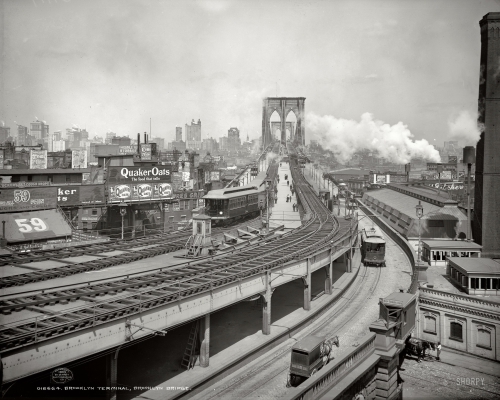
In the headlines this morning, we linked to a great historical photo of the approach to the Brooklyn Bridge on Brownstoner, and it's taking a closer look at the full implications of the shot. Not for nostalgia's sake, but to make a cool, calculated appraisal of the efficiency of this piece of transportation infrastructure, as currently configured.


The 1903 image shows the bridge with only one lane in each direction for private vehicles, which at the time were drawn by horses. The rest of the space is given over to tracks for streetcars, elevated railroads, and pedestrians. Now, of course, there's still a shared bike-ped path through the middle of the bridge, but the rest of it is all for cars, with three lanes of automobile traffic running on either side. No buses or trucks run over the bridge.
If the job of the Brooklyn Bridge is to move people between the two boroughs, the reallocation of space from transit to cars has been disastrous. In 1902, one year before the photograph was taken, the Brooklyn Bridge moved roughly 341,000 people a day across all its modes, according to the Federal Highway Administration. It hit its peak capacity a few years later, with 426,000 people using it each day in 1907.
Today, 125,000 motor vehicles cross the Brooklyn Bridge each day [PDF], as do roughly 4,000 pedestrians and 2,600 cyclists. For the bridge to carry as many people as it did at its peak, each of those cars would need to carry more than three people, but they do not. In 1989, when the city counted around 132,000 motor vehicles crossing, the FHWA estimated that 178,000 people crossed the bridge daily.
More than a century has passed since this photo was taken, and the Brooklyn Bridge's capacity has declined by an enormous amount, thanks to the elimination of transit across it. You just can't fit enough bulky and mostly empty cars on the bridge for it to add up.
There's an interesting discussion on Brownstoner about which picture represents the more bustling and vital city: the old Brooklyn Bridge with transit, or the current one with lots of cars? The transit-friendly bridge may look less busy than the traffic-clogged bridge of today, but the numbers show that looks are deceiving: The less-full bridge was actually the more active and functional bridge.
The past and present of the Brooklyn Bridge embody the transportation capacity that NYC has given up by catering to the less efficient mode. Today, running streetcar tracks along the bridge wouldn't do too much good, seeing as how the city's entire streetcar network has been ripped out, and the same goes for the els. Where the dismantling of those two transit systems wasn't replaced by equivalent subway or bus service, as on the Brooklyn Bridge, the result is a transportation system that simply moves fewer people.





